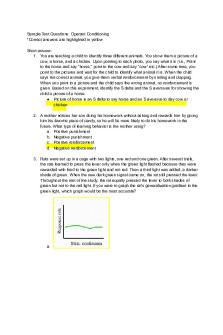Psych - 1x03 Instrumental Conditioning PDF

| Title | Psych - 1x03 Instrumental Conditioning |
|---|---|
| Author | a g |
| Course | Intro to Psych |
| Institution | McMaster University |
| Pages | 2 |
| File Size | 93.5 KB |
| File Type | |
| Total Downloads | 74 |
| Total Views | 202 |
Summary
kim...
Description
Continuous reinforcement: a response leads to a reinforcer on every single trial. This schedule of reinforcement is called continuous reinforcement PARTIAL REINFORCEMENT SCHEDULES - A ratio schedule of reinforcement is based on the number of responses made by a subject, which determines when reinforcement is given. Reward is given every certain number responses - A pigeon is rewarded with food for every tenth pecking response - FR-6 pecks - An interval schedule of reinforcement is based on the time since the last response that was reinforced. - Pigeon oon FI-1 minute schedule is rewarded with food every 1 minute period Both ratio and interval schedules can be either fixed or variable - Following are example of fixed schedules - On an FR 10 schedule, the pigeon must peck exactly 10 times to get the food reward. - On the FI-10 minute schedule the pigeons first peck response after exactly 10 minutes is rewarded with food In both cases, these conditions were held constant across trials. Lets now consider the variable schedule twist. In contrast to a fixed schedule, rewards on variable ratio and interval scaled are provided following a variable amount of work or length of time -
Example: on a VR 10 schedule, the pigeon must peck an average of 10 times to get food reward but the exact number of pecks that yields a rewards changes across trials - When you look at the overall rate of reinforcement, it works out that on average 10 pecks were necessary on any given trial. On a VI-10 min schedule, the first response following an average of 10 min will be reinforced, but the exact length of time between rewards changes across trials
There is a limit to how stingy an FR-fixed ratio schedule can be. - A schedule that is too stingy will lead to ratio strain and the subject will stop responding - Pause and run pattern on the graph for a FR-fixed ratio schedule - Variable ratio schedule is capable of supporting very constant and high exposure rate on graph - A cumulative record of responses reinforced on a variable ratio schedule may almost look like a diagonal line with no pauses between - The slope of a variable ratio schedule’s cumulative record reflects the average number of responses required before reinforcement is delivered. - Variable schedules that deliver more frequent reinforcement will support higher response rates - A VR-10 schedule will have a steeper slope than a VR-40 schedule -
Fixed ratio schedule: pause and run pattern Variable ratio schedule: diagonal line with no pauses between Fixed interval schedule: scallop pattern Variable interval schedule: diagonal line. Increases at a steady rate. Straight line on the cumulative record - reinforcement can be received at any time...
Similar Free PDFs

Psych 1x03 - tutorial work
- 1 Pages

Psych 1x03 final review
- 48 Pages

Psych 1X03 - Tutorial 1 Notes
- 3 Pages

1X03 - syllabus - mcmaster
- 10 Pages

Syllabus 1X03 Fall 2019
- 19 Pages

Instrumental
- 15 Pages

Innovate 1X03 Reflection 2
- 3 Pages

Instrumental odontología
- 18 Pages
Popular Institutions
- Tinajero National High School - Annex
- Politeknik Caltex Riau
- Yokohama City University
- SGT University
- University of Al-Qadisiyah
- Divine Word College of Vigan
- Techniek College Rotterdam
- Universidade de Santiago
- Universiti Teknologi MARA Cawangan Johor Kampus Pasir Gudang
- Poltekkes Kemenkes Yogyakarta
- Baguio City National High School
- Colegio san marcos
- preparatoria uno
- Centro de Bachillerato Tecnológico Industrial y de Servicios No. 107
- Dalian Maritime University
- Quang Trung Secondary School
- Colegio Tecnológico en Informática
- Corporación Regional de Educación Superior
- Grupo CEDVA
- Dar Al Uloom University
- Centro de Estudios Preuniversitarios de la Universidad Nacional de Ingeniería
- 上智大学
- Aakash International School, Nuna Majara
- San Felipe Neri Catholic School
- Kang Chiao International School - New Taipei City
- Misamis Occidental National High School
- Institución Educativa Escuela Normal Juan Ladrilleros
- Kolehiyo ng Pantukan
- Batanes State College
- Instituto Continental
- Sekolah Menengah Kejuruan Kesehatan Kaltara (Tarakan)
- Colegio de La Inmaculada Concepcion - Cebu







